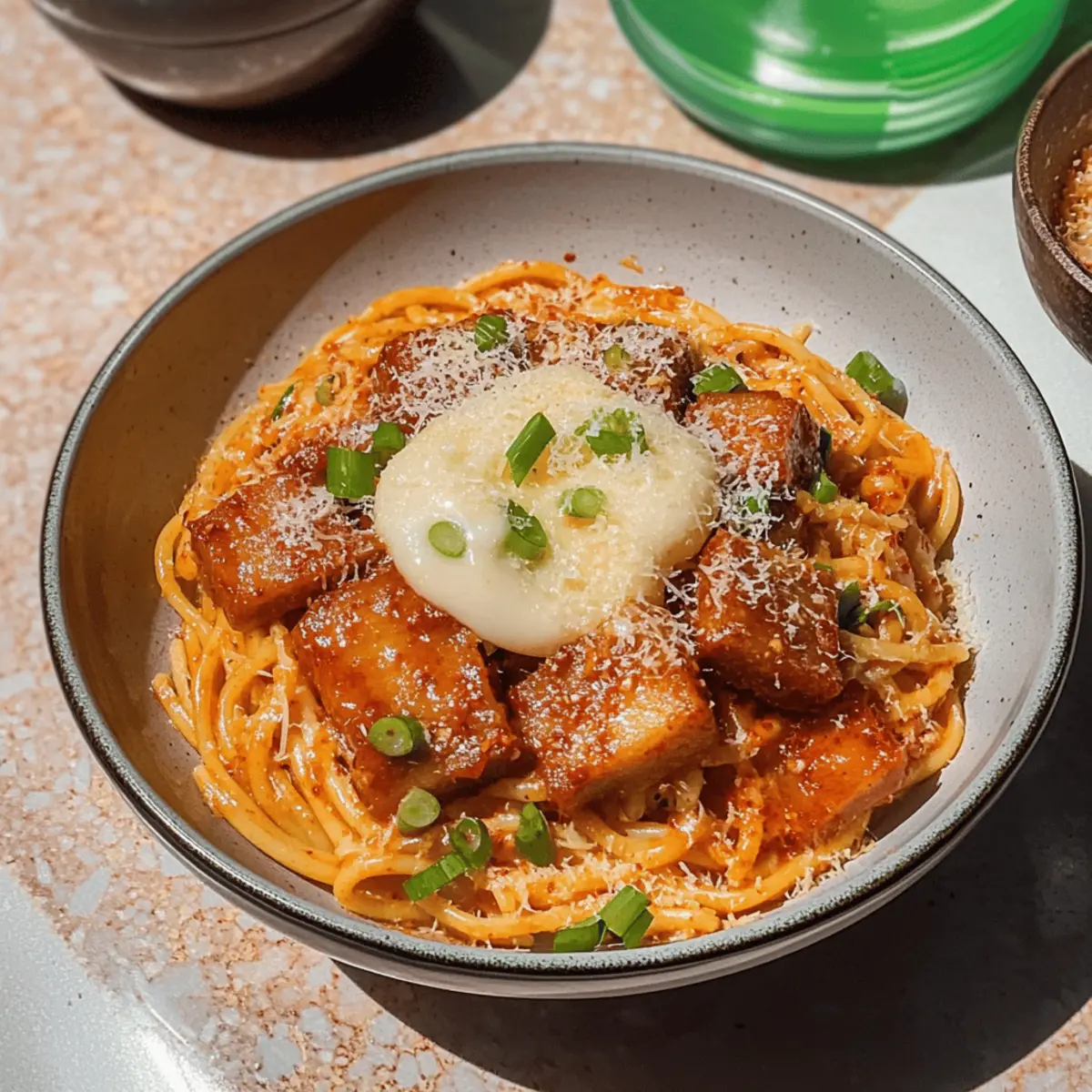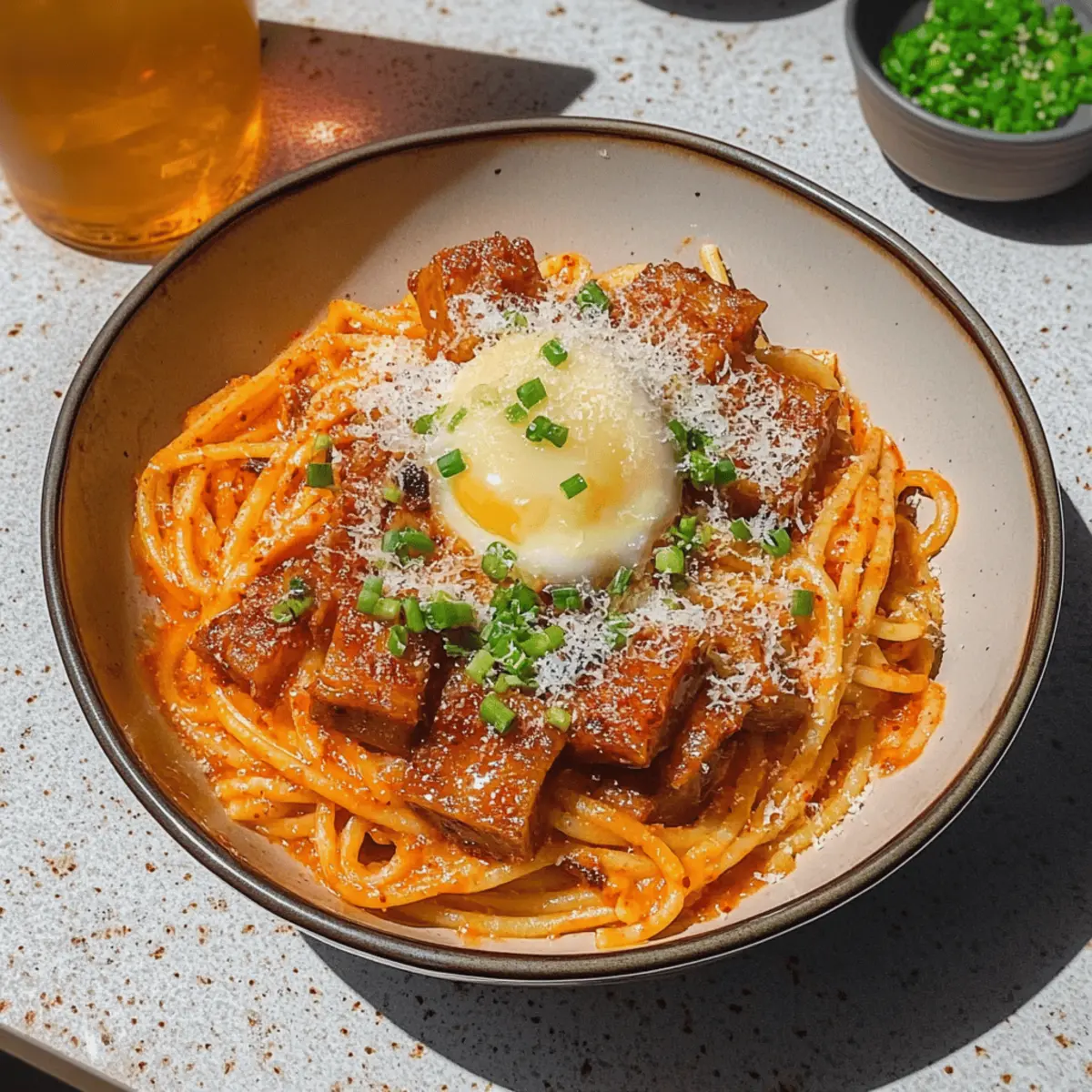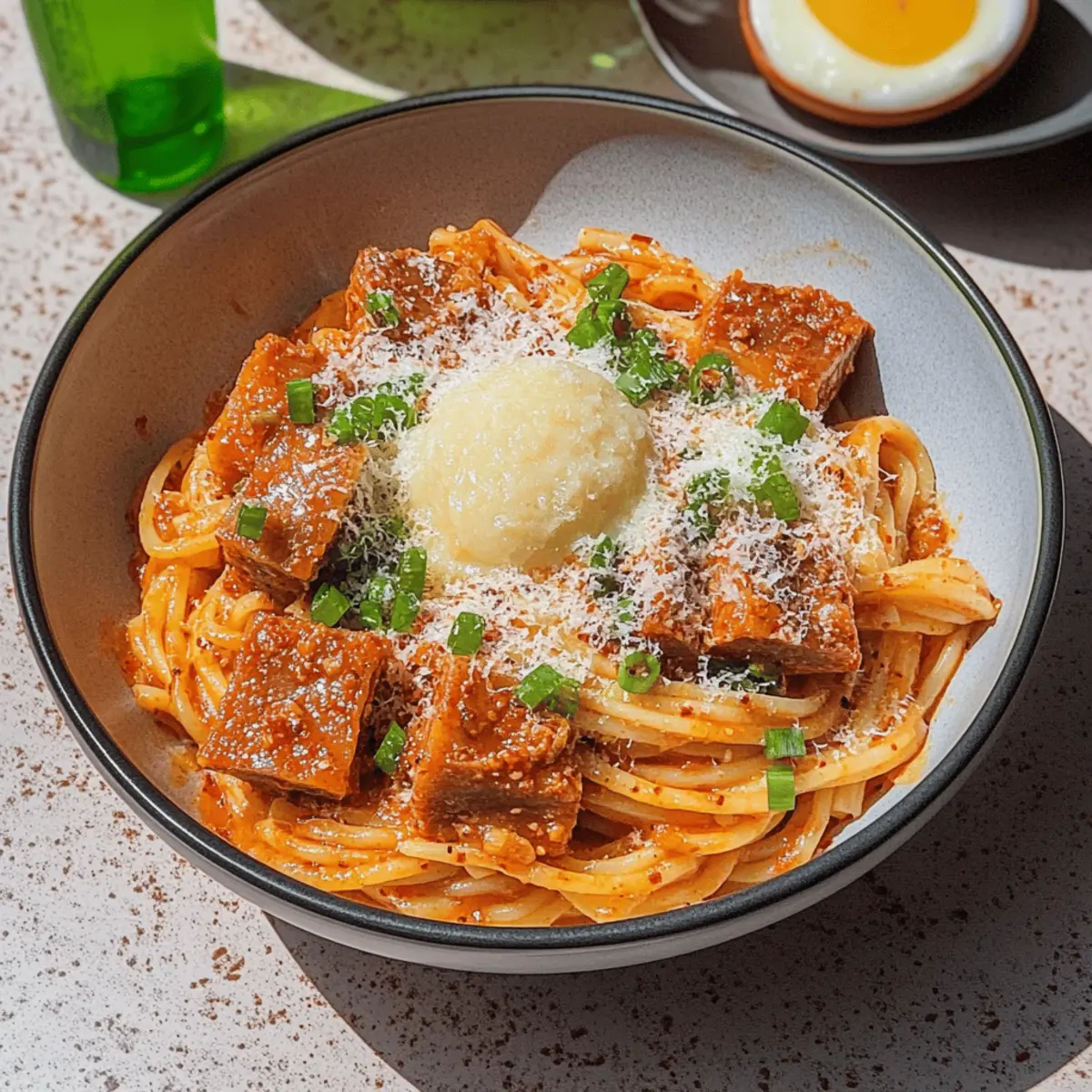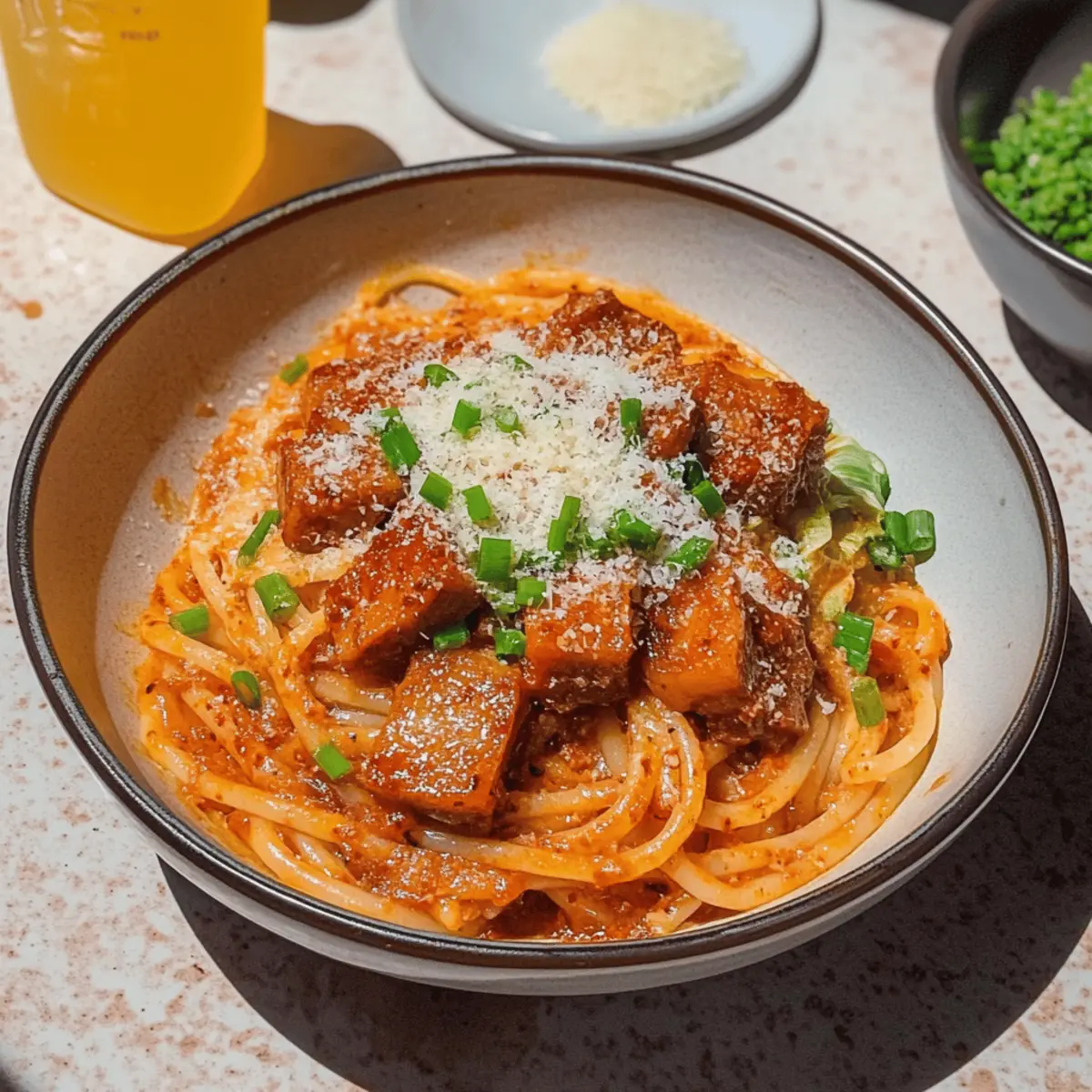As I stirred the pasta in the pot, a fragrant aroma wafted through my kitchen, instantly transporting me to the bustling streets of Seoul. This Creamy Korean Ssamjang Pasta takes just 25 minutes to prepare, transforming a simple weeknight dinner into a hearty, restaurant-worthy feast. Featuring succulent pork belly and a rich, umami-packed sauce that beautifully marries spicy ssamjang with creamy elements, this dish is both quick and irresistible. Plus, it’s incredibly adaptable! You can switch out the pork for chicken or even tofu for a satisfying vegetarian option, ensuring it’s a crowd-pleaser for everyone at the table. Are you curious about how this fusion dish will tantalize your taste buds? Let’s dive into the recipe!

Why Is This Korean Ssamjang Pasta Unique?
Flavorful Fusion: The combination of creamy pasta and spicy ssamjang creates a harmonious blend that’s both comforting and exciting.
Quick Prep: In just 25 minutes, you can whip up a dish that looks and tastes like a gourmet meal.
Versatile Ingredients: Feel free to swap pork belly for chicken or tofu – perfect for flexitarian diets!
Umami Richness: Ssamjang packs a punch of umami that elevates traditional pasta to new heights.
Crowd-Pleaser: This dish is sure to impress family and friends, serving as a delightful alternative to fast food or standard weeknight meals.
If you’re intrigued by more bold flavors, check out Korean Fried Chicken for another delicious twist!
Korean Ssamjang Pasta Ingredients
Unleash your culinary creativity with this savory recipe!
For the Pasta
- Pasta – Use any preferred type like spaghetti or fettuccine for a delightful base.
- Salt – Essential for enhancing the pasta’s flavor; adjust according to your taste.
For the Sauce
- Ssamjang (쌈장) – The star of the show, providing spicy umami depth; you can substitute with gochujang for a different kick.
- Pork Belly – Adds richness and an irresistible crunch; chicken or tofu work as lighter alternatives.
- Parmesan Cheese – Offers creaminess and a savory finish; feel free to swap with nutritional yeast for a vegan twist.
- Egg – Creates a luscious creaminess when mixed in; omit or replace with silken tofu for a vegan option.
For Toppings
- Green Onions – Adds a fresh crunch on top; chives or shallots are excellent substitutes for varying flavors.
With these ingredients, you’re on your way to creating a flavorful Korean Ssamjang Pasta that will bring joy to your dinner table!
Step‑by‑Step Instructions for Korean Ssamjang Pasta
Step 1: Cook the Pasta
Bring a large pot of salted water to a rolling boil and add your choice of pasta, such as spaghetti or fettuccine. Cook according to the package instructions until al dente, approximately 8–10 minutes. Stir occasionally, ensuring the pasta doesn’t stick. Once cooked, reserve 1 cup of pasta water, then drain the remaining water and set the pasta aside.
Step 2: Prepare the Pork Belly
In a large skillet over medium-high heat, add diced pork belly and cook until crispy and golden brown, about 5–7 minutes. Stir occasionally to ensure even cooking and to render the fat. Once browned, remove the pork belly from the pan and place it on a paper towel-lined plate to drain any excess grease, leaving the flavorful drippings in the pan.
Step 3: Create the Sauce
Return the skillet to medium heat and add the reserved cup of pasta water along with the ssamjang paste. Whisk together until the sauce is smooth and creamy, simmering for about 2–3 minutes. The goal is to bring out the rich umami of the ssamjang, creating a delightful fusion that will envelop the pasta beautifully.
Step 4: Combine Ingredients
Add the drained pasta and crispy pork belly into the skillet with the creamy ssamjang sauce. Toss everything together gently using tongs or a spatula, ensuring each strand of pasta is coated well with the savory sauce. Continue tossing for about 2 minutes, allowing the pasta to absorb the delicious flavors while heating through.
Step 5: Finish and Serve
Remove the skillet from heat and stir in the grated parmesan cheese and a beaten egg. Mix quickly until creamy and cohesive, allowing the residual heat to cook the egg slightly without scrambling it. Serve immediately, topped with freshly chopped green onions for a burst of flavor and a beautiful presentation on your Korean Ssamjang Pasta.

Variations & Substitutions for Korean Ssamjang Pasta
Feel free to explore these delightful twists that will personalize your dish and make it even more exciting!
-
Gochujang Swap: Use gochujang instead of ssamjang for a milder, sweeter flavor. This swap keeps the essence of Korean cuisine intact but with a softer spice.
-
Chicken or Tofu Instead: Swap pork belly for grilled chicken breast or firm tofu for a lighter and plant-based option. Each brings its unique texture and taste, maintaining that delightful umami we love.
-
Add Spinach: Toss in fresh spinach or kale towards the end of cooking for a pop of color and nutrients. The greens wilt beautifully, adding freshness to your creamy pasta.
-
Baby Bell Peppers: Slice and sauté baby bell peppers for a sweet crunch. Their vibrant colors will make the dish visually stunning as well.
-
Sesame Oil Drizzle: Finish with a drizzle of toasted sesame oil. This small addition adds a nutty richness that elevates the overall flavor profile.
-
Vegan Parmesan: Substitute traditional parmesan with nutritional yeast for a vegan-friendly creamy finish. It retains that cheesy flavor without any dairy.
-
Spicy Crushed Peppers: Add crushed red pepper flakes for an extra heat kick. This is perfect if you want to turn the spice level up a notch!
-
Mushroom Magic: Sauté shiitake or button mushrooms to add a savory depth to the dish. Their earthy flavor pairs beautifully with the ssamjang sauce.
For more exciting Korean flavors, why not try out these Korean Fried Chicken or Korean BBQ Meatballs? Embrace the journey of flavor and satisfaction in your cooking!
What to Serve with Creamy Korean Ssamjang Pasta
Creating the perfect dining experience is all about complementing flavors and textures that entice your senses.
-
Crispy Tempura Vegetables: The light, crunchy texture of tempura vegetables adds a delightful contrast to the creamy pasta. Pair them with a dipping sauce for an extra flavor kick!
-
Korean Pickled Radishes: Their sharp, tangy flavor cuts through the richness of the ssamjang pasta, refreshing your palate with each bite. A perfect side for balancing flavors.
-
Steamed Broccoli: The green, slightly bitter notes of steamed broccoli provide a nutritious touch, enhancing the dish’s visual appeal while adding much-needed color.
-
Seaweed Salad: Light and briny, this salad offers a unique texture and flavor, marrying beautifully with the umami notes of the pasta. The seaweed’s chewy consistency adds intrigue to your meal.
-
Sweet Korean Corn Cheese: This warm, cheesy side has a delightful sweetness that complements the spicy pasta perfectly, creating harmony between flavors that delight every taste bud.
-
Cold Beer or Soju: A crisp lager or a shot of soju adds a lively fizz or kick, enhancing the overall experience of your meal while cooling down the spice level.
-
Korean Chocolate Cake: Wrap up the dinner with something sweet. The rich and moist chocolate cake cannily contrasts the rich flavors of the pasta, ensuring a memorable end to your meal.
How to Store and Freeze Korean Ssamjang Pasta
Fridge: Store leftovers in an airtight container for up to 3 days. This keeps your creamy Korean Ssamjang Pasta fresh and flavorful for a quick meal later on.
Freezer: If you plan to freeze, portion out and freeze the pasta in airtight containers. It can last up to 3 months. Thaw overnight in the fridge before reheating.
Reheating: Gently reheat on the stove with a splash of water or additional pasta water to bring back creaminess and flavor. Stir occasionally to avoid drying out.
Room Temperature: It’s best to refrain from leaving cooked pasta out at room temperature for more than 2 hours to maintain safety and quality.
Make Ahead Options
These Creamy Korean Ssamjang Pasta are perfect for busy weeknights! You can prep the pasta and the pork belly up to 24 hours in advance. Cook the pasta as directed, but stop cooking just before it’s al dente; drain and toss it in a little olive oil to prevent sticking, then refrigerate. For the pork belly, cook it until crispy, then allow it to cool before storing it in an airtight container. When you’re ready to serve, simply reheat both components in a pan, add in the ssamjang sauce (made fresh), and finish with parmesan and egg. This way, you’ll enjoy a delicious meal with minimal effort and just as delightful flavors!
Tips for the Best Korean Ssamjang Pasta
- Don’t Overcook: Ensure the pasta is cooked al dente; it will continue to cook slightly when mixed with the sauce.
- Pasta Water is Gold: Always reserve that cup of pasta water; its starchiness helps emulsify the sauce beautifully.
- Sauté Properly: Cook the pork belly until it’s golden brown and crispy for a contrasting texture in your creamy sauce.
- Savvy Seasoning: Taste and adjust the salt as ssamjang already has a salty profile; you may need less than usual.
- Egg Trick: Add your beaten egg quickly after removing from heat. This prevents scrambling and keeps the sauce creamy.

Korean Ssamjang Pasta Recipe FAQs
What type of pasta works best for Korean Ssamjang Pasta?
Absolutely! You can use any type of pasta you prefer, such as spaghetti or fettuccine. Just be sure to cook it al dente, so it maintains a nice bite and doesn’t become mushy when combined with the sauce.
How long can I store leftovers of Korean Ssamjang Pasta?
Leftovers can be stored in an airtight container in the fridge for up to 3 days. This allows you to enjoy the savory flavors without any fuss during busy weeknights. Just reheat gently to keep it creamy!
Can I freeze Korean Ssamjang Pasta?
Yes, you can! Portion out the pasta in airtight containers and freeze for up to 3 months. When you’re ready to enjoy it, simply thaw in the fridge overnight. Reheat gently on the stove, adding a splash of water or some reserved pasta water to restore creaminess.
What’s a good substitution for ssamjang if I can’t find it?
Very! If you can’t find ssamjang, gochujang is an excellent alternative—it’s a bit milder and offers a sweet-spicy flavor. You can also use doubanjiang for a different flavor twist, but adjust the amount based on your spice preference.
Are there any dietary considerations with Korean Ssamjang Pasta?
Definitely! If you’re cooking for someone with dietary restrictions, you can substitute pork belly with grilled chicken or tofu for a lighter option. For a vegan version, omit the egg and use nutritional yeast instead of parmesan cheese. Just double-check the labels on your ssamjang, as some brands may contain allergens.
How do I prevent the pasta from drying out during reheating?
To avoid drying out, gently reheat your Korean Ssamjang Pasta on the stove with a splash of water or some reserved pasta water. Stir occasionally while warming it up to ensure the sauce stays creamy and delicious. Enjoy!

Savory Korean Ssamjang Pasta: Quick, Creamy, and Irresistible
Ingredients
Equipment
Method
- Bring a large pot of salted water to a boil and cook the pasta according to package instructions until al dente, about 8–10 minutes. Reserve 1 cup of pasta water, then drain the remaining water and set the pasta aside.
- In a large skillet over medium-high heat, cook diced pork belly until crispy and golden brown, about 5–7 minutes. Remove from pan, leaving drippings.
- Return the skillet to medium heat, add reserved pasta water and ssamjang, whisk until smooth and creamy. Simmer for 2–3 minutes.
- Add drained pasta and crispy pork belly into the skillet, toss gently to coat with sauce for about 2 minutes.
- Remove from heat, stir in parmesan cheese and beaten egg until creamy. Serve topped with green onions.


